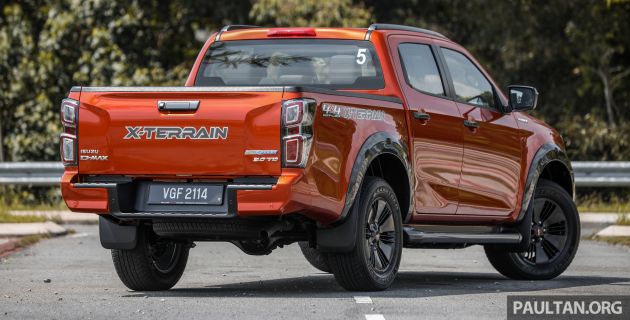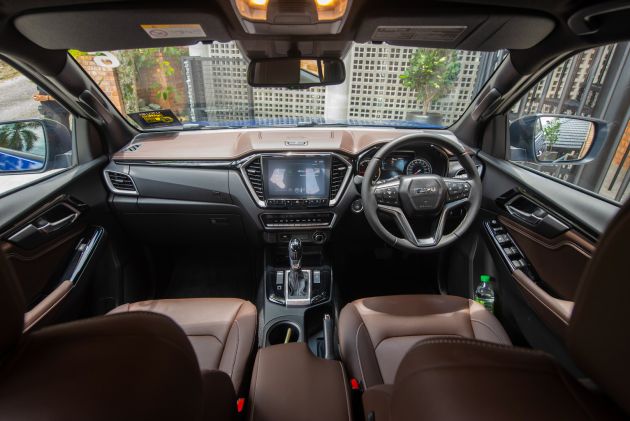At long last, the third-generation Isuzu D-Max has finally landed in Malaysia. At launch, there will be seven variants on offer, starting with the 1.9L 4×4 Single Cab at RM88,599, and goes all the way up to RM141,938 for the top 3.0L 4×4 AT X-Terrain variant. We’ll have a breakdown of each variant and its equipment, below. And yes, all seven variants are 4×4 models.
A lot has been done to bring the D-Max up to par with competitors. Isuzu director and chief engineer Chifumi Saito said the third-gen model was developed from the outset to meet increasingly tough customer demands, which prioritised having more creature comforts, higher interior quality, and more power and torque.
Since it’s essentially still a workhorse, we’ll start with the powertrain, of which there are two. Cheaper variants get the existing RZ4E-TC 1.9 litre common-rail four-cylinder diesel engine with variable geometry turbo, producing 150 PS and 350 Nm of torque. Outputs are unchanged, but Isuzu says it is more refined now, and offers better throttle response.
The big news here is the 4JJ3 3.0 litre engine, which powers the top two 4×4 AT Premium and 4×4 AT X-Terrain models, as well as the 4×4 Single Cab. It produces 190 PS and 450 Nm of torque, representing a 13 PS and 70 Nm increase over the older 4JJ1 3.0L unit, thanks to a new engine head and turbocharger.
On paper, the 3.0L mill’s output may appear to be lagging behind the competition, but Isuzu typically “downtunes” the engine in favour of reliability. After all, durability is key to its customer base, plus both the 1.9L and 3.0L engines can take up to B20 biodiesel. Also new are the six-speed manual and six-speed automatic transmissions (both tweaked to provide smoother gearshifts), as well as a shift-by-wire 4×4 selector dial.
Let’s start with the base 1.9L 4×4 Single Cab model. At RM88,599, it gets halogen reflector headlights with bulb-type daytime running lights, unpainted front bumper and wing mirror caps (power adjustable mirrors, though), 16-inch steel wheels, basic backlit analogue instrumentation, four-spoke urethane steering wheel, 1-Din head unit with USB and two speakers, vinyl seats, and manual climate control system.
Safety-wise, it gets dual airbags, ABS with EBD, hill start assist, hill descent control, traction control system, and seat belt reminder for all seats. There is also the the 3.0L 4×4 Single Cab, which retails for RM95,538. Engines aside, these two are identical in terms of equipment, and they are only available in solid Splash White paint. The bed liner is a RM950 option, by the way, and the sports bar costs an additional RM1,320.
Above that is the 1.9L 4×4 MT Standard, priced at RM99,599. This twin-cab variant gets upgraded with painted front bumper and wing mirror caps, halogen fog lamps, 17-inch alloys with 255/65 profile tyres, reverse parking sensors, a nicer instrument cluster with a 4.2-inch multi-info display, multifunction urethane steering wheel, woven cloth seats, 2-Din head unit with Bluetooth and six speakers, plus rear air vents with 2.1A USB charging ports (standard for all twin-cab variants).
For a little bit more money you can get the 1.9L 4×4 AT Standard, which goes for RM106,999. Here, it tacks on bi-LED projector headlights with LED daytime running lights, but the rest remain the same. The MT Standard can be had in three colours (Splash White, Mercury Silver and Onyx Black), while the AT Standard adds on Valencia Orange and Sapphire Blue for a total of five.
The variant that most people will start considering from is the 1.9L 4×4 AT Premium. It’s priced at RM121,549 and gets automatic bi-LED projector headlights, LED front and rear fog lamps, LED combination tail lights, chrome wing mirrors with auto-fold function, 18-inch alloys with 265/60 all-terrain tyres, leather-wrapped multifunction steering wheel, and a seven-inch touchscreen head unit with Apple CarPlay, Android Auto and WiFi functionalities.
It also gets eight speakers (with ceiling-mounted tweeters), black combination leather seats, more premium leather and satin chrome trimmings, electrochromic rear-view mirror, and dual-zone automatic climate control system. Other conveniences include passive cruise control, keyless entry with push-start, welcome lights, reverse camera, and a tailgate assist system.
Unfortunately, the advanced driver assist system is only limited to blind spot monitoring and rear cross-traffic alert, and the AT Premium still comes with just two front airbags. The exterior colour palette comprises the same five hues as the 1.9L 4×4 AT Premium, but the Splash White paint gets replaced with the more premium Silky White Pearl instead.
Sliding in at RM128,038 is the 3.0L 4×4 AT Premium. Upgrading to this V-Cross variant only nets you the larger powertrain, as well as a six-way manual adjustment for the driver seat. The airbag count still two.
Last but not least is the range-topping 3.0L 4×4 AT X-Terrain. It’s priced at RM141,938, representing a jump of nearly RM14k over the 3.0L AT Premium. For that kind of money, you get a special windscreen that cuts infrared light transmission, premium aerofoil wiper blades with integrated windshield washer nozzles, 18-inch dark grey alloys wrapped with 265/60 all-terrain tyres, a differential lock, and remote engine start.
Inside, it is the only variant to get the nicer brown leather upholstery, dark headlining, eight-way power adjustable driver seat with lumbar support, tilt and telescopic steering adjustment, as well as a larger nine-inch touchscreen display.
In terms of safety, it gets the full shebang, with seven airbags, forward collision warning, autonomous emergency braking, adaptive cruise control with stop and go functionality, auto high beam, lane departure warning, pedal misapplication mitigation, and turn assist offered as standard. There’s still no 360-degree surround view camera, so it makes do with just a reverse camera and parking sensors.
Just to recap, the new D-Max rides on Isuzu’s new Dynamic Drive Platform (still a body-on-frame construction), offering better structural rigidity, crash protection, driving stability and the reduction of NVH levels. The intake system has been raised, thus increasing wading depth from 600 mm to 800 mm.
Other areas of improvement include a 30 mm increase in wheelbase, revised rear door apertures that open wider for better ingress and egress, a 20 mm increase in rear shoulder space, and a seatback angle of 24 degrees. The brakes are larger (320 mm x 30 mm rotors), and the suspension geometry has been tweaked as well.
It also features a more wedge-shaped profile for improved aerodynamics, a larger underbody cover that reduces turbulence, cleaner body lines for smoother air flow, and taller cargo side walls with a slightly redesigned cargo bay.
Those who plan to take it off road will be glad to know that the front underbody section is protected with a 1.5 mm-thick steel skid plate, plus an additional 6 mm steel sump guard for the engine and gearbox. There’s also a 5 mm resin wind deflector on top of that, and the ground clearance is 240 mm (models equipped with 18-inch wheels only).
Lastly, the D-Max gets a five-year or 150,000 km warranty coverage as standard, but only the range-topping 3.0L 4×4 AT X-Terrain gets a seven-year unlimited mileage warranty coverage. The X-Terrain is also available in Valencia Orange and Sapphire Blue only. The D-Max will officially be launched on April 26.
Source: Read Full Article








